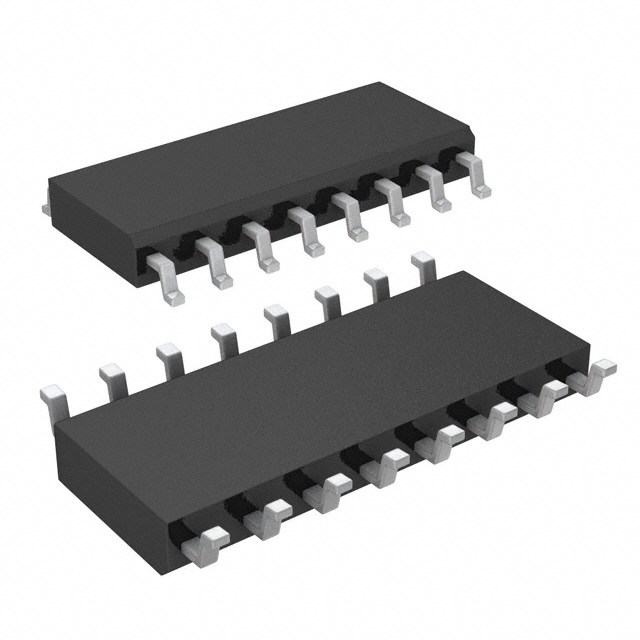Xem thông số kỹ thuật để biết chi tiết sản phẩm.

LTC1383CS#TRPBF
Product Overview
Category
LTC1383CS#TRPBF belongs to the category of integrated circuits (ICs).
Use
This product is commonly used in electronic devices for signal transmission and communication purposes.
Characteristics
- LTC1383CS#TRPBF is a low-power, high-speed RS485/RS422 transceiver.
- It operates with a supply voltage range of 3V to 5.5V.
- The device supports data rates up to 20Mbps.
- It features a half-duplex configuration.
- LTC1383CS#TRPBF has a wide common-mode voltage range, making it suitable for noisy environments.
- It offers thermal shutdown protection and failsafe receiver inputs.
Package
LTC1383CS#TRPBF is available in a small surface-mount package, specifically SOIC-8.
Essence
The essence of LTC1383CS#TRPBF lies in its ability to provide reliable and efficient RS485/RS422 communication in various applications.
Packaging/Quantity
This product is typically packaged in reels or tubes, containing a specific quantity per package. Please refer to the manufacturer's datasheet for detailed packaging information.
Specifications
- Supply Voltage Range: 3V to 5.5V
- Data Rate: Up to 20Mbps
- Operating Temperature Range: -40°C to 85°C
- Half-Duplex Configuration
- Common-Mode Voltage Range: ±7V
- Package Type: SOIC-8
Detailed Pin Configuration
- DE - Driver Output Enable
- RE - Receiver Output Enable
- A - Non-Inverting Differential Input/Output A
- B - Inverting Differential Input/Output B
- GND - Ground
- Y - Receiver Output
- VCC - Supply Voltage
- Z - Receiver Output
Functional Features
- Low-power consumption
- High-speed data transmission
- Wide common-mode voltage range for reliable operation in noisy environments
- Thermal shutdown protection
- Failsafe receiver inputs ensure a known output state when inputs are open or shorted
Advantages and Disadvantages
Advantages
- Supports high data rates up to 20Mbps
- Wide common-mode voltage range enhances noise immunity
- Low power consumption extends battery life in portable applications
- Thermal shutdown protection prevents damage due to excessive temperature
- Failsafe receiver inputs provide reliable operation in fault conditions
Disadvantages
- Limited to half-duplex communication only
- Requires external components for complete functionality
- May not be suitable for applications requiring full-duplex communication
Working Principles
LTC1383CS#TRPBF operates as an RS485/RS422 transceiver by converting the differential signals between A and B inputs into single-ended signals suitable for communication with other devices. The driver outputs, DE and RE, control the direction of data transmission. The receiver outputs, Y and Z, provide the received data to the connected device.
Detailed Application Field Plans
LTC1383CS#TRPBF finds application in various fields, including: 1. Industrial automation systems 2. Building automation and control systems 3. Data communication networks 4. Instrumentation and measurement equipment 5. Automotive electronics 6. Security systems 7. Telecommunication infrastructure
Detailed and Complete Alternative Models
- MAX485 - RS485/RS422 Transceiver
- SN75176 - RS485/RS422 Differential Bus Transceiver
- ADM485 - Half-Duplex RS485 Transceiver
- SP3485 - Full-Duplex RS485 Transceiver
- ST485 - Low Power RS485 Transceiver
These alternative models offer similar functionality and can be considered as substitutes for LTC1383CS#TRPBF in various applications.
Note: The content provided above is a sample structure for an encyclopedia entry. Additional information and details can be added as per the specific requirements.
Liệt kê 10 câu hỏi và câu trả lời thường gặp liên quan đến ứng dụng LTC1383CS#TRPBF trong giải pháp kỹ thuật
Sure! Here are 10 common questions and answers related to the application of LTC1383CS#TRPBF in technical solutions:
Q: What is LTC1383CS#TRPBF? A: LTC1383CS#TRPBF is a specific model number for a communication IC (integrated circuit) developed by Linear Technology (now part of Analog Devices). It is commonly used in technical solutions that require reliable data transmission over long distances.
Q: What are the key features of LTC1383CS#TRPBF? A: Some key features of LTC1383CS#TRPBF include low power consumption, high noise immunity, wide operating voltage range, and compatibility with various communication protocols such as RS485 and RS422.
Q: How does LTC1383CS#TRPBF ensure reliable data transmission over long distances? A: LTC1383CS#TRPBF incorporates features like differential signaling, which helps in reducing noise interference and improving signal integrity. It also has built-in protection mechanisms against voltage spikes and other electrical disturbances.
Q: Can LTC1383CS#TRPBF be used in industrial automation applications? A: Yes, LTC1383CS#TRPBF is commonly used in industrial automation applications due to its robustness, noise immunity, and ability to transmit data over long distances reliably.
Q: Is LTC1383CS#TRPBF suitable for battery-powered devices? A: Yes, LTC1383CS#TRPBF is designed to operate at low power levels, making it suitable for battery-powered devices where power efficiency is crucial.
Q: What is the maximum data rate supported by LTC1383CS#TRPBF? A: The maximum data rate supported by LTC1383CS#TRPBF is typically around 20 Mbps, depending on the specific application and operating conditions.
Q: Can LTC1383CS#TRPBF be used in point-to-point communication systems? A: Yes, LTC1383CS#TRPBF can be used in point-to-point communication systems as well as multi-drop networks, making it versatile for various applications.
Q: Does LTC1383CS#TRPBF require external components for operation? A: Yes, LTC1383CS#TRPBF requires a few external components such as resistors and capacitors to set the desired operating parameters and ensure proper functionality.
Q: Is LTC1383CS#TRPBF compatible with other communication ICs? A: Yes, LTC1383CS#TRPBF is compatible with other communication ICs that adhere to the RS485 or RS422 standards, allowing for seamless integration into existing systems.
Q: Where can I find more information about LTC1383CS#TRPBF and its application notes? A: You can find more detailed information about LTC1383CS#TRPBF, including application notes and datasheets, on the Analog Devices website or by contacting their technical support team.

